
The Colombian artist Luis Fernando Zapata had a short yet prolific artistic life profoundly affected by the advent of the AIDS epidemic and reflected in the research he conducted in his many travels through the Colombian ancient cultures, the Egiptian trans continent and the Middle East. His journeys clearly marked his iconography and his personal one further more. We have chosen the title “The inmemorial, life and art of Luis Fernando Zapata based on the Jean-Francios Lyotard’s idea of the “immemorial,” which he describes as “that which can never be remembered (represented to consciousness) nor forgotten (consigned to oblivion). It is that which returns uncannily.” It is now, in the 30th anniversary of his passing due to AIDS related complications that we celebrate his life in the most uncanny possible way, honoring his artistic life and presenting a comprehensive exhibition of each and everyone of his series.
Since the beginning, Elvira Moreno Gallery has established itself as a space focused on research, experimentation and the visibility of artistic proposals that reflect on the transcendence of contemporary art in relation and dialogue with its geographical, political and social contexts. It also centers on the historical influences that Colombian and Latin American art have on the international cultural scene, as well as a critical review of the various modernist and avant-garde movements of the twentieth century. Its director, Elvira Moreno, has made an effort to lead, under a multidisciplinary approach, projects that include in their programming various disciplines such as videographic digitalization, dance, music and gastronomy through proposals that use experimental technologies, applying them to the demands of the diverse cultural industries of the present. Our space is located in Barrio San Felipe, in the Arts District of Bogota. This neighborhood has become a place of great impulse and creative life where galleries, artists' workshops and platforms that promote the various artistic events converge, influencing the cultural morphology of what Colombia is today. Elvira Moreno Gallery is a center for humanistic reflection that focuses on the representation of emerging and established artists. It is also concerned with making visible the legacy of those referential artists in the history of national and international art through programmed management that involves the coordination of documentary exhibitions, participation in art fairs and through collaborative projects with galleries, curators and international cultural organizations. Our main mission is to establish a frank, coherent and permanent dialogue with our audiences through an institutional approach that is mainly supported by sustained research projects, in order to establish a dialogic relationship from a cultural and historical horizon with academia, specialized collectors and the public that supports us.
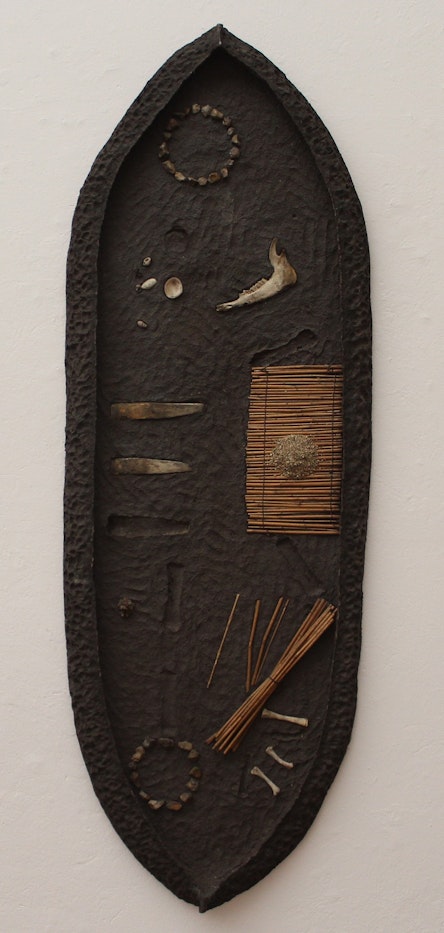
Luis Fernando Zapata (Colombia, 1951 - 1994) was a Colombian artist whose work focused on the expression of imponderable and eternal notions. Implicit in the character of his works was an inclination towards a restrained gesture, towards a presence that does not provoke disturbance, nourished by a provincial origin that kept him safe from any fickleness of the current artistic scene. Fatality would make this natural principle the best vehicle for his searches and idealised reconstructions of millenary rites and magical invocations. The work of Luis Fernando Zapata from 1990 onwards, refers to an enquiry into the first artistic forms, to the mystery of the disappearance of art and the reasons for its existence. However, the support of his pieces transcends the naturalistic essence of prehistoric art as understood by the animalistic figures found in some current expressions. But it is part of the context in which, through the symbolism of burials and excavations, an attempt is made to discover " gates of light " towards new visions of our world. The Tombs, Sarcophagi and Funeral Boats were prominent works which symbolised vehicles of travel towards an immaterial dimension, a theme which Zapata devoted himself to expressing for most of his artistic life.

Luis Fernando Zapata (Colombia, 1951 - 1994) was a Colombian artist whose work focused on the expression of imponderable and eternal notions. Implicit in the character of his works was an inclination towards a restrained gesture, towards a presence that does not provoke disturbance, nourished by a provincial origin that kept him safe from any fickleness of the current artistic scene. Fatality would make this natural principle the best vehicle for his searches and idealised reconstructions of millenary rites and magical invocations. The work of Luis Fernando Zapata from 1990 onwards, refers to an enquiry into the first artistic forms, to the mystery of the disappearance of art and the reasons for its existence. However, the support of his pieces transcends the naturalistic essence of prehistoric art as understood by the animalistic figures found in some current expressions. But it is part of the context in which, through the symbolism of burials and excavations, an attempt is made to discover " gates of light " towards new visions of our world. The Tombs, Sarcophagi and Funeral Boats were prominent works which symbolised vehicles of travel towards an immaterial dimension, a theme which Zapata devoted himself to expressing for most of his artistic life.
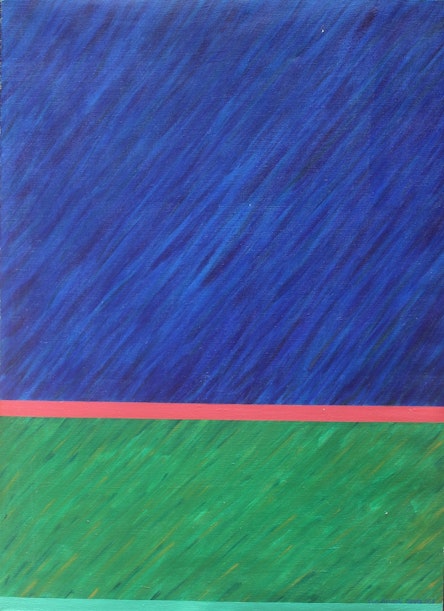
Luis Fernando Zapata (Colombia, 1951 - 1994) was a Colombian artist whose work focused on the expression of imponderable and eternal notions. Implicit in the character of his works was an inclination towards a restrained gesture, towards a presence that does not provoke disturbance, nourished by a provincial origin that kept him safe from any fickleness of the current artistic scene. Fatality would make this natural principle the best vehicle for his searches and idealised reconstructions of millenary rites and magical invocations. The work of Luis Fernando Zapata from 1990 onwards, refers to an enquiry into the first artistic forms, to the mystery of the disappearance of art and the reasons for its existence. However, the support of his pieces transcends the naturalistic essence of prehistoric art as understood by the animalistic figures found in some current expressions. But it is part of the context in which, through the symbolism of burials and excavations, an attempt is made to discover " gates of light " towards new visions of our world. The Tombs, Sarcophagi and Funeral Boats were prominent works which symbolised vehicles of travel towards an immaterial dimension, a theme which Zapata devoted himself to expressing for most of his artistic life.

Luis Fernando Zapata (Colombia, 1951 - 1994) was a Colombian artist whose work focused on the expression of imponderable and eternal notions. Implicit in the character of his works was an inclination towards a restrained gesture, towards a presence that does not provoke disturbance, nourished by a provincial origin that kept him safe from any fickleness of the current artistic scene. Fatality would make this natural principle the best vehicle for his searches and idealised reconstructions of millenary rites and magical invocations. The work of Luis Fernando Zapata from 1990 onwards, refers to an enquiry into the first artistic forms, to the mystery of the disappearance of art and the reasons for its existence. However, the support of his pieces transcends the naturalistic essence of prehistoric art as understood by the animalistic figures found in some current expressions. But it is part of the context in which, through the symbolism of burials and excavations, an attempt is made to discover " gates of light " towards new visions of our world. The Tombs, Sarcophagi and Funeral Boats were prominent works which symbolised vehicles of travel towards an immaterial dimension, a theme which Zapata devoted himself to expressing for most of his artistic life.

Luis Fernando Zapata (Colombia, 1951 - 1994) was a Colombian artist whose work focused on the expression of imponderable and eternal notions. Implicit in the character of his works was an inclination towards a restrained gesture, towards a presence that does not provoke disturbance, nourished by a provincial origin that kept him safe from any fickleness of the current artistic scene. Fatality would make this natural principle the best vehicle for his searches and idealised reconstructions of millenary rites and magical invocations. The work of Luis Fernando Zapata from 1990 onwards, refers to an enquiry into the first artistic forms, to the mystery of the disappearance of art and the reasons for its existence. However, the support of his pieces transcends the naturalistic essence of prehistoric art as understood by the animalistic figures found in some current expressions. But it is part of the context in which, through the symbolism of burials and excavations, an attempt is made to discover " gates of light " towards new visions of our world. The Tombs, Sarcophagi and Funeral Boats were prominent works which symbolised vehicles of travel towards an immaterial dimension, a theme which Zapata devoted himself to expressing for most of his artistic life.
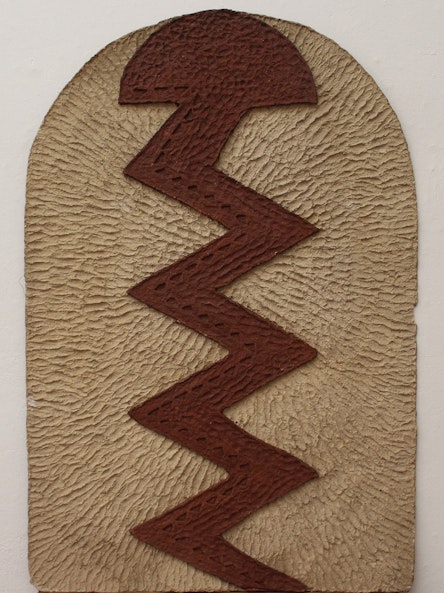
Luis Fernando Zapata (Colombia, 1951 - 1994) was a Colombian artist whose work focused on the expression of imponderable and eternal notions. Implicit in the character of his works was an inclination towards a restrained gesture, towards a presence that does not provoke disturbance, nourished by a provincial origin that kept him safe from any fickleness of the current artistic scene. Fatality would make this natural principle the best vehicle for his searches and idealised reconstructions of millenary rites and magical invocations. The work of Luis Fernando Zapata from 1990 onwards, refers to an enquiry into the first artistic forms, to the mystery of the disappearance of art and the reasons for its existence. However, the support of his pieces transcends the naturalistic essence of prehistoric art as understood by the animalistic figures found in some current expressions. But it is part of the context in which, through the symbolism of burials and excavations, an attempt is made to discover " gates of light " towards new visions of our world. The Tombs, Sarcophagi and Funeral Boats were prominent works which symbolised vehicles of travel towards an immaterial dimension, a theme which Zapata devoted himself to expressing for most of his artistic life.
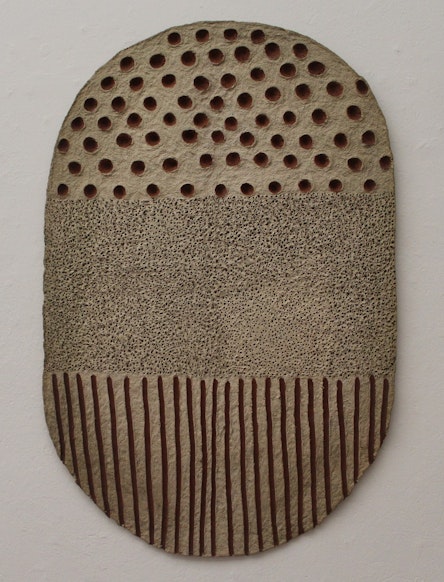
Luis Fernando Zapata (Colombia, 1951 - 1994) was a Colombian artist whose work focused on the expression of imponderable and eternal notions. Implicit in the character of his works was an inclination towards a restrained gesture, towards a presence that does not provoke disturbance, nourished by a provincial origin that kept him safe from any fickleness of the current artistic scene. Fatality would make this natural principle the best vehicle for his searches and idealised reconstructions of millenary rites and magical invocations. The work of Luis Fernando Zapata from 1990 onwards, refers to an enquiry into the first artistic forms, to the mystery of the disappearance of art and the reasons for its existence. However, the support of his pieces transcends the naturalistic essence of prehistoric art as understood by the animalistic figures found in some current expressions. But it is part of the context in which, through the symbolism of burials and excavations, an attempt is made to discover " gates of light " towards new visions of our world. The Tombs, Sarcophagi and Funeral Boats were prominent works which symbolised vehicles of travel towards an immaterial dimension, a theme which Zapata devoted himself to expressing for most of his artistic life.

Luis Fernando Zapata (Colombia, 1951 - 1994) was a Colombian artist whose work focused on the expression of imponderable and eternal notions. Implicit in the character of his works was an inclination towards a restrained gesture, towards a presence that does not provoke disturbance, nourished by a provincial origin that kept him safe from any fickleness of the current artistic scene. Fatality would make this natural principle the best vehicle for his searches and idealised reconstructions of millenary rites and magical invocations. The work of Luis Fernando Zapata from 1990 onwards, refers to an enquiry into the first artistic forms, to the mystery of the disappearance of art and the reasons for its existence. However, the support of his pieces transcends the naturalistic essence of prehistoric art as understood by the animalistic figures found in some current expressions. But it is part of the context in which, through the symbolism of burials and excavations, an attempt is made to discover " gates of light " towards new visions of our world. The Tombs, Sarcophagi and Funeral Boats were prominent works which symbolised vehicles of travel towards an immaterial dimension, a theme which Zapata devoted himself to expressing for most of his artistic life.

Luis Fernando Zapata (Colombia, 1951 - 1994) was a Colombian artist whose work focused on the expression of imponderable and eternal notions. Implicit in the character of his works was an inclination towards a restrained gesture, towards a presence that does not provoke disturbance, nourished by a provincial origin that kept him safe from any fickleness of the current artistic scene. Fatality would make this natural principle the best vehicle for his searches and idealised reconstructions of millenary rites and magical invocations. The work of Luis Fernando Zapata from 1990 onwards, refers to an enquiry into the first artistic forms, to the mystery of the disappearance of art and the reasons for its existence. However, the support of his pieces transcends the naturalistic essence of prehistoric art as understood by the animalistic figures found in some current expressions. But it is part of the context in which, through the symbolism of burials and excavations, an attempt is made to discover " gates of light " towards new visions of our world. The Tombs, Sarcophagi and Funeral Boats were prominent works which symbolised vehicles of travel towards an immaterial dimension, a theme which Zapata devoted himself to expressing for most of his artistic life.
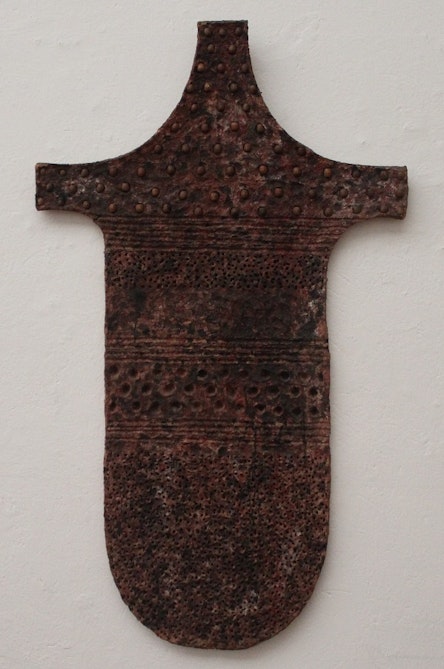
Luis Fernando Zapata (Colombia, 1951 - 1994) was a Colombian artist whose work focused on the expression of imponderable and eternal notions. Implicit in the character of his works was an inclination towards a restrained gesture, towards a presence that does not provoke disturbance, nourished by a provincial origin that kept him safe from any fickleness of the current artistic scene. Fatality would make this natural principle the best vehicle for his searches and idealised reconstructions of millenary rites and magical invocations. The work of Luis Fernando Zapata from 1990 onwards, refers to an enquiry into the first artistic forms, to the mystery of the disappearance of art and the reasons for its existence. However, the support of his pieces transcends the naturalistic essence of prehistoric art as understood by the animalistic figures found in some current expressions. But it is part of the context in which, through the symbolism of burials and excavations, an attempt is made to discover " gates of light " towards new visions of our world. The Tombs, Sarcophagi and Funeral Boats were prominent works which symbolised vehicles of travel towards an immaterial dimension, a theme which Zapata devoted himself to expressing for most of his artistic life.